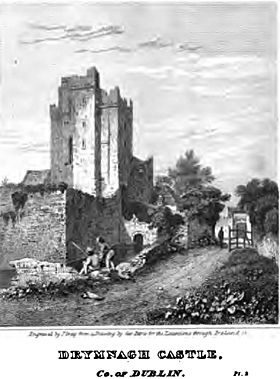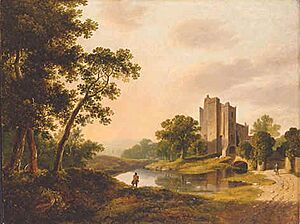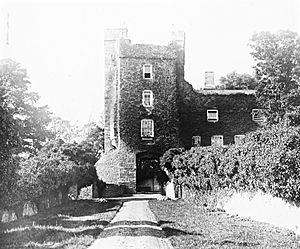Drimnagh Castle facts for kids
Quick facts for kids Drimnagh Castle |
|
|---|---|
|
Caisleán Dhroimeanaigh
|
|

Drimnagh Castle c.1820
|
|
| General information | |
| Town or city | Dublin |
| Country | Ireland |
| Coordinates | 53°19′30″N 6°19′58″W / 53.324973°N 6.332840°W |
Drimnagh Castle (Irish: Caisleán Dhroimeanaigh) is a historic castle in Drimnagh, a part of Dublin, Ireland. It was built by the Normans, a group of people who came from France. This castle is special because it's the only one left in Ireland that still has a moat filled with water all around it. The water for the moat comes from a small river nearby called the Camac. Right next to the castle, you'll find Drimnagh Castle Secondary School.
Castle History

The first known owner of Drimnagh Castle was Sir Hugh de Bernival in 1216. His family, who later became known as Barnewell or Barnewall, owned the castle for many hundreds of years.
The Barnewell family first built a strong building here in the mid-1200s. However, most of the castle you see today was built in the early 1400s. Inside the moat, there's a large hall from the 1400s and a tower added later, in the 1500s or 1600s. There's also a big stone building from the early 1900s. This building was used for different things, like a stable for horses, a ballroom for dances, and a coach house for carriages.
By the mid-1800s, a rich nobleman called the Marquess of Lansdowne owned the castle. A book from 1837 described it as an "irregular pile," meaning it was a collection of buildings that didn't look perfectly neat. At that time, a Mr. E. Cavanagh lived there.
In the early 1900s, a dairy farmer named Joseph Hatch bought the castle and its land. He needed the land for his cattle to graze. Joseph Hatch was also a member of the Dublin City Council. He worked to fix up the castle, and it became a summer home for his family. They even celebrated his silver wedding anniversary and his eldest daughter's wedding there in 1910.
When Joseph Hatch passed away in 1918, his eldest son, Joseph Aloysius, who was called Louis, took over the castle. Louis and his brother Hugh ran the family's dairy farm and shop. Louis never married and passed away in 1951.
The Hatch family lived in Drimnagh Castle until the mid-1950s. Louis Hatch left the castle to Dr. P. Dunne, a bishop. The bishop then sold it to the Christian Brothers, a religious group, for a very small amount of money. They wanted to build a school next to the castle. The Christian Brothers lived and taught at the castle until 1956, when their new school and monastery were ready nearby.
In 1978, a local sports club called An Caisleán Gaelic Athletic Association (now St James Gaels GAA club) took over the castle's coach-house. They fixed it up to create a clubhouse, a hall, a kitchen, and changing rooms for their members.
By the mid-1980s, the castle was in bad shape. Its roofs had fallen in, windows were missing, and some walls were collapsing. In 1986, an artist named Peter Pearson worked with An Taisce, Ireland's national trust. They started a project to save and restore the castle. All the work was done by hand. They built a new oak roof for the great hall, just like it would have been in the 1400s. They also made stone windows and used old building methods. A beautiful medieval-style garden was also created.
Drimnagh Castle opened to the public again in 1991. More restoration work continued throughout the 1990s.
As of 2025, you can visit Drimnagh Castle for tours. It's also a popular place for weddings and other events. You can even take courses there to learn how to build dry stone walls.
Filming Location
Drimnagh Castle has been used as a setting for several movies and TV shows. Some of these include The Abduction Club (2002), Ella Enchanted (2004), and The Tudors (2007).


